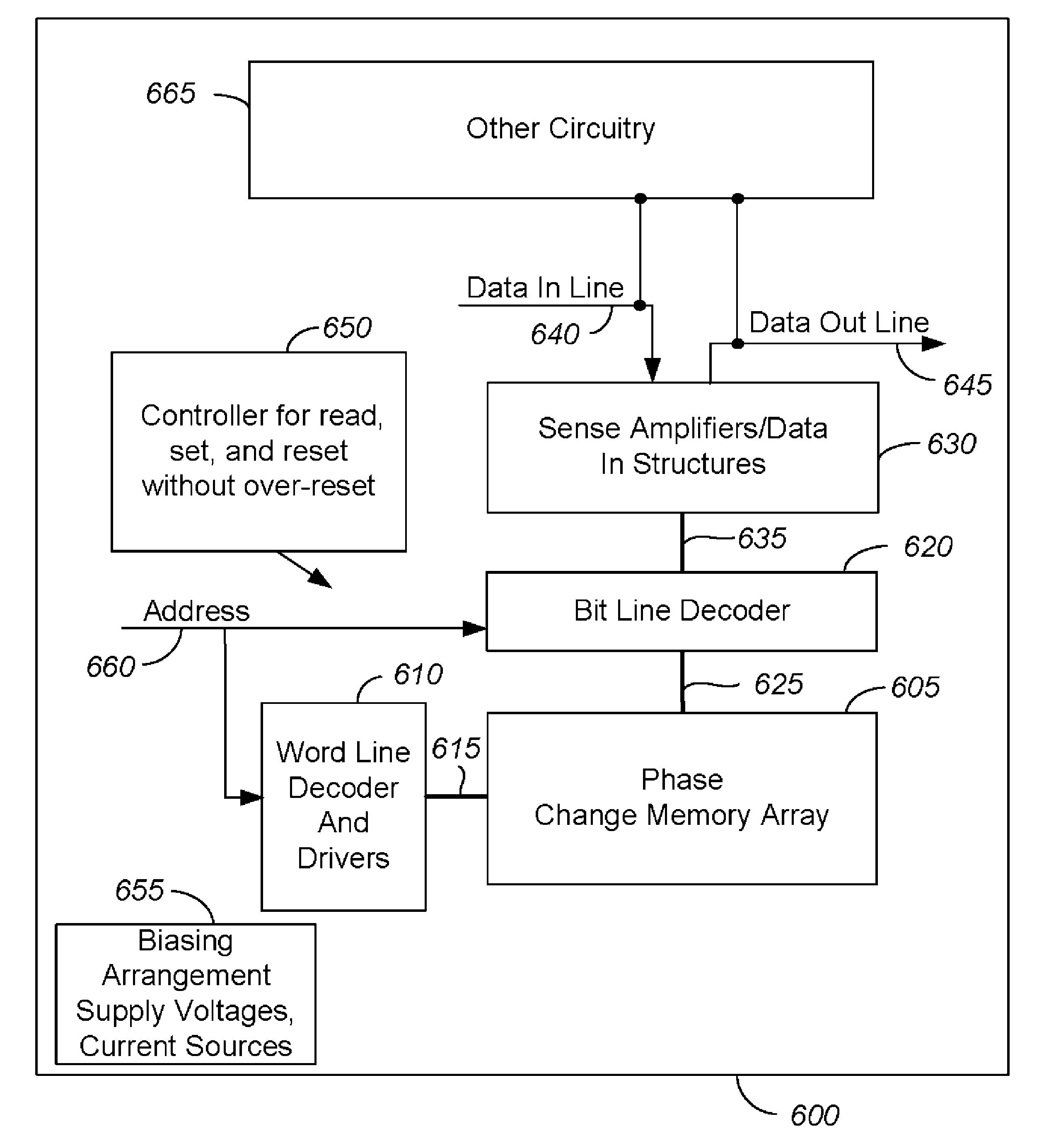Phase change memory program method without over-reset
a program method and memory technology, applied in the field of memory devices, can solve problems such as insufficient resistance state change, and achieve the effect of avoiding unnecessarily high reset currents and avoiding over-res
- Summary
- Abstract
- Description
- Claims
- Application Information
AI Technical Summary
Benefits of technology
Problems solved by technology
Method used
Image
Examples
first embodiment
FIG. 7 illustrates a first embodiment for array 605 of the integrated circuit 600. As shown in the embodiment of FIG. 7, each of the memory cells of array 605 includes an field effect transistor access device, eight of which are shown as memory cells 701-708 having respective phase change memory elements 711-718 are illustrated in FIG. 7, representing a small section of an array that can include millions of memory cells. The memory elements are programmable to a plurality of resistance states including a high resistance state and at least one lower resistance state.
Sources of each of the access transistors of memory cells 711-718 are connected to common line 796 that terminates in a line termination circuit 795, such as a ground terminal. In another embodiment the sources of the access devices are not electrically connected, but independently controllable. The line termination circuit 795 may include bias circuits such as voltage sources and current sources, and decoding circuits fo...
second embodiment
In the timing diagram of FIG. 10 the voltage pulses of increasing pulse height were applied between the word line 736a and the common line 796. FIG. 12 illustrates a timing diagram of the reset operation 900 of FIG. 9 in which the voltage pulses of increasing pulse height are applied between the bit line 726a and the common line 796.
In FIG. 12, a series of four control voltage pulses having substantially the same pulse height VWL sufficient to turn on the access transistor are applied to the word line 736a, and the common line 796 coupled to the source terminal is supplied a ground potential.
As can be seen in FIG. 12, the voltage on the bit line 726a increases in a stepped fashion from VB1, VB2, VB3, VB4 between each of the control pulses applied to the word line 736a. Although the voltage on the bit line increases in a stepped fashion, as used herein the voltage on the bit line is considered to be a pulse when the control voltage pulse is sufficient turn on the access transistor an...
third embodiment
FIG. 14 illustrates the array in which the memory cells are implemented using diode access devices, and FIG. 15 illustrates a simplified timing diagram of the reset operation 900 of FIG. 9 for the memory cells of FIG. 14.
In the timing diagram of FIG. 15 the fixed sequence of voltage pulses of increasing pulse height are applied to the bit line 726a and the word line 736a is supplied a constant voltage (ground in this example). Thus, the voltage pulses of increasing pulse height from Vinitial to Vend are applied across the series arrangement of the diode and the memory element 711 for the memory cell 701 to cause increasing current in path 751 and through the memory element 711 until change to the higher resistance state occurs. Additionally, the voltage pulses in the fixed sequence are adapted to cause a voltage across the memory element 711 after the memory element 711 is in the higher resistance state that is less than the threshold voltage VTH. Thus, once the memory element 711 i...
PUM
 Login to View More
Login to View More Abstract
Description
Claims
Application Information
 Login to View More
Login to View More - R&D
- Intellectual Property
- Life Sciences
- Materials
- Tech Scout
- Unparalleled Data Quality
- Higher Quality Content
- 60% Fewer Hallucinations
Browse by: Latest US Patents, China's latest patents, Technical Efficacy Thesaurus, Application Domain, Technology Topic, Popular Technical Reports.
© 2025 PatSnap. All rights reserved.Legal|Privacy policy|Modern Slavery Act Transparency Statement|Sitemap|About US| Contact US: help@patsnap.com



